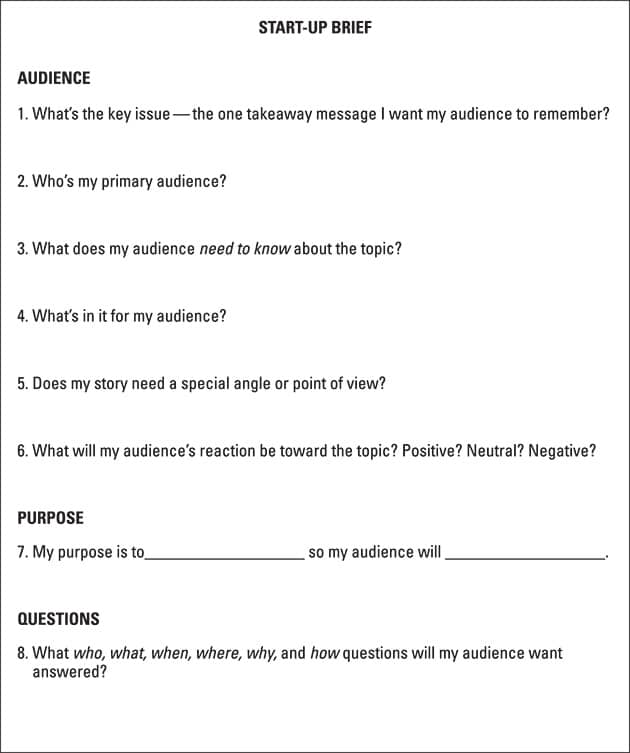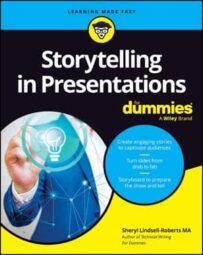 ©.shock / Adobe Stock
©.shock / Adobe StockThe attorneys can relate stories aimed at strengthening their clients’ cases to sway the jurors. The jurors become the heroes because they (presumably) reach a fair and equitable judgment. The selection of jurors can contribute to winning or losing the case even before it’s even tried.
Let’s relate this to presentations. As you are beginning to create a presentation, of course you won’t select your audience, but the same principle of knowing them applies in order to have a winning presentation (for them and you). When you fill out the Start-Up Brief (see the figure below), you learn all you can about your audience so you can target stories and the entire presentation toward the outcome you intend, and they’ll leave as heroes.
 ©John Wiley & Sons, Inc.
©John Wiley & Sons, Inc.Use the Start-Up Brief to make sure you know your audience.
Knowing your audience
When people ask the question "how to create a presentation?" or "how to create a PowerPoint presentation?" they're often only thinking about the technical aspects, like how to put together slides. You will need to do that, if there's nobody else to do it for you. However, a flashy PowerPoint or Canva slideshow should not be your goal. It's far more important to focus on the substance of the presentation, and one of the first things to consider about the substance is "who will make up your audience?"The better you understand your audience, the better you’ll be able to craft messages and stories they care about in terms of their interests, level of understanding, attitudes, and needs. Here's more to consider about each of the questions in the Start-Up Brief:
1. What’s the key issue — the one takeaway message I want my audience to remember?
Your audience won’t remember everything you say or show. What’s the one message you want them to remember above all else? This is like an earworm. If you haven’t heard that term, it’s a tune you hear that plays over and over in your head that you can’t seem to shake.- What do you want your audience’s earworm to be?
- What should they do? Think? Feel? Learn?
Condense the key message into one sentence. Until you can do that, you won’t be focused. Imagine you have just one minute to get your key issue across clearly. What would that message be?
2. Who’s my primary audience?
Why is it so easy to communicate with friends or close colleagues? Because you know them. You know their preconceived idea, level of expertise, probable reaction, and so forth. The same theory applies to your audience. Understand who they’ll be and whether they’re attending by choice.There are so many types of audiences you may encounter. Here are just a few:
- Peers or subordinates
- Senior-level managers
- Middle-level managers
- Technical or non-technical
- Internal to your company or external
- Competitors
- Buyers
- Merchandisers
- Sales associates
- Customers (new and/or potential)
- Customer service
If the makeup of your audience isn’t apparent, here are a few things you might try:
- Conduct surveys, questionnaires, or interviews with the event organizers. They may have knowledge of job titles, industries, and even a breakdown of age and gender.
- Survey the audience before the event. Ask what they hope to do, think, feel, or learn as a result of attending. Also inquire about their knowledge of the subject matter, organizations they belong to, volunteer activities, and so on.
- Tap into social media. If you have access to the event's social media accounts, check out who’s following or engaging with them.
- Observe the audience and conduct informal conversations before the presentation starts.
3. What does my audience need to know about the topic?
Please pay attention to the words need to know. Too often we give too much or too little information. For example, if you’re discussing a specific aspect of genetic engineering but your audience isn’t familiar with basic genetics, you’ll have missed the mark. On the other hand, drastically underestimating the audience’s knowledge may result in a presentation that sounds condescending. For a mixed audience, consider reviewing important key terms and concepts so everyone starts with baseline knowledge. Here are some things to think about:- Does your audience have any preconceived ideas?
- Are there any barriers to their understanding (language, cultural, technical, or other)?
- Will there be any resistance?
- Will there be any adversaries?
- Will you have supporters?
4. What’s in it for my audience?
Have you ever listened to WIIFM? The answer is “yes,” you listen to it all the time — What’s In It For Me? Whenever you listen to something, you unknowingly ask yourself, “Why should I care?” On the job, you might ask if this an opportunity to look good to superiors, make your job easier, solve a problem, or learn a new skill. If you didn’t care, you wouldn’t be listening.Dial in to WIIFM to make sure you understand what’s in it for your audience. Dig deeply. For example, if you’re teaching them a new skill, will it impact their job performance? Help them look good to management? Ultimately get them a pay raise or promotion? You don’t want anyone sitting in your audience waiting to find out what’s in it for them. Let them know right up front.
5. Does my presentation need a special angle or point of view?
Managers typically need the big picture to make big decisions. The lower down the chain of command, the more details may be needed. Technical people want all the details. Salespeople need benefits. Potential customers want to know why they should select you.When presenting to hybrid audiences, key phrases may be:
- I’d like to take a few minutes to make sure we’re we are all up to speed on the three key aspects of [topic].
- The crux of the matter is …
- The big picture is …
- Let me give you some examples …
- In practice this means …
6. What will my audience’s reaction be toward the topic? Positive? Neutral? Negative?
You may not tell people what they want to hear, but you must tell them what they need to hear. What will their reaction be? Positive? Neutral? Negative? If you’re not sure, ask yourself the following questions:- Are you disputing existing data?
- Will you create more work for them?
- Are they attending by choice, or were they forced (strongly urged)?
- Are they interested in the topic?
- Will your information come as a surprise?
- What is their relationship with you and with each other?
- How will the presentation help them perform their jobs better?
- What are the most interesting parts of the topic?
- How much will the audience know about the topic?
- Which audience members may be more/less interested?
- Delivering a positive or neutral topic: When your audience will be positive or neutral, use the BLUF (Bottom Line Up Front) approach. Your presentation isn’t a joke where you need to put the punch line at the end. Tell them what they need to know right at the beginning. We’ve all sat through long, boring presentations waiting to hear the most important part we came to learn — the conclusion or findings.
- Delivering a negative topic: Strategically build up to your main message. Create a sandwich with good news, negative news, good news. Give reasons why. Offer options. Make lemonade.
What is the purpose of your presentation?
Whether you think your purpose is to communicate, inform, sell, or whatever, chances are you’re trying to “persuade” someone to do, think, feel, or learn something. Once you realize that most of what you present is to persuade — your message will be “strategic,” not generic.Keep peeling the onion (as the expression goes) because an underlying or unspoken purpose often boils down to money. For example, assume your presentation is to introduce a new corporate initiative. The unspoken message to those who embrace the initiative may be to perform better, look good to their superiors, increase the company’s earnings, or perhaps be thought of more favorably when raises or promotions are due.
The takeaway message you’ll fill in on the second blank line (that follows) is the call to action. What do you want your audience to do, think, or feel, or learn? Your intention must be clear in your own mind so you can make it clear in theirs. What’s their call to action? What’s in it for them? Too many presenters don’t get the action they wanted because they didn’t make the expectation clear.
To state your strategic purpose and the call to action, fill in the blanks of the following statement:
My purpose is to ________________ so my audience will _____________________________________________.
Anticipating questions from your audience
You may not think of every question your audience may have and need answered, but the following will help you consider as many as you can. They all relate to any or all of the following:What who, what, when, where, why, and how questions will my audience want answered?
For practice, let’s assume I’m inviting you to a meeting. There are questions you’ll undoubtedly have when you receive the invitation, such as:
- Who else will be there?
- What is the agenda?
- When will the meeting be held?
- Where will it be held?
- Why am I being asked to attend?
- How can I prepare and contribute?
- Column 1: Questions to ask yourself to prepare your presentation.
- Column 2: Questions you anticipate the audience will ask that you should include in your presentation or be prepared to answer.
Questions to Ask When Preparing for a Presentation
| Your Questions | Audience’s Questions | |
| Who … | ...will be supportive and make supportive comments? ...will be adversarial and make combative comments? ...may feel threatened by my recommendations? ...is my contact person for logistical and other issues? ...should I bring in as a subject matter expert? |
...is responsible? ...will be impacted by the change? |
| What … | ...are the major concerns of my audience? ...can I tell or show to help them address those concerns? ...stories can help them remember key points? ...do they know about the topic? ...is my relationship with them? ...obstacles may I encounter? ...discussion points should I encourage? ...tough questions should I expect? |
...are the alternatives? ...are the advantages and/or disadvantages? ...are the next steps? ...if we do nothing? |
| When … | ...is the best time to deliver this presentation? ...should I distribute the handouts? |
...does this take effect? ...do you need a decision? |
| Where … | ...can the audience get more information? ...can I get more information? |
...will the funding come from? ...can I get more information? |
| Why … | ...is the audience attending? ...was I chosen to make this presentation? |
...are you recommending this? |
| How … | ...much time should I spend on providing background? (Do they need any background?) ...will I open/close the presentation? ...does this relate to the strategic impact on the organization? |
...will we measure success? |

